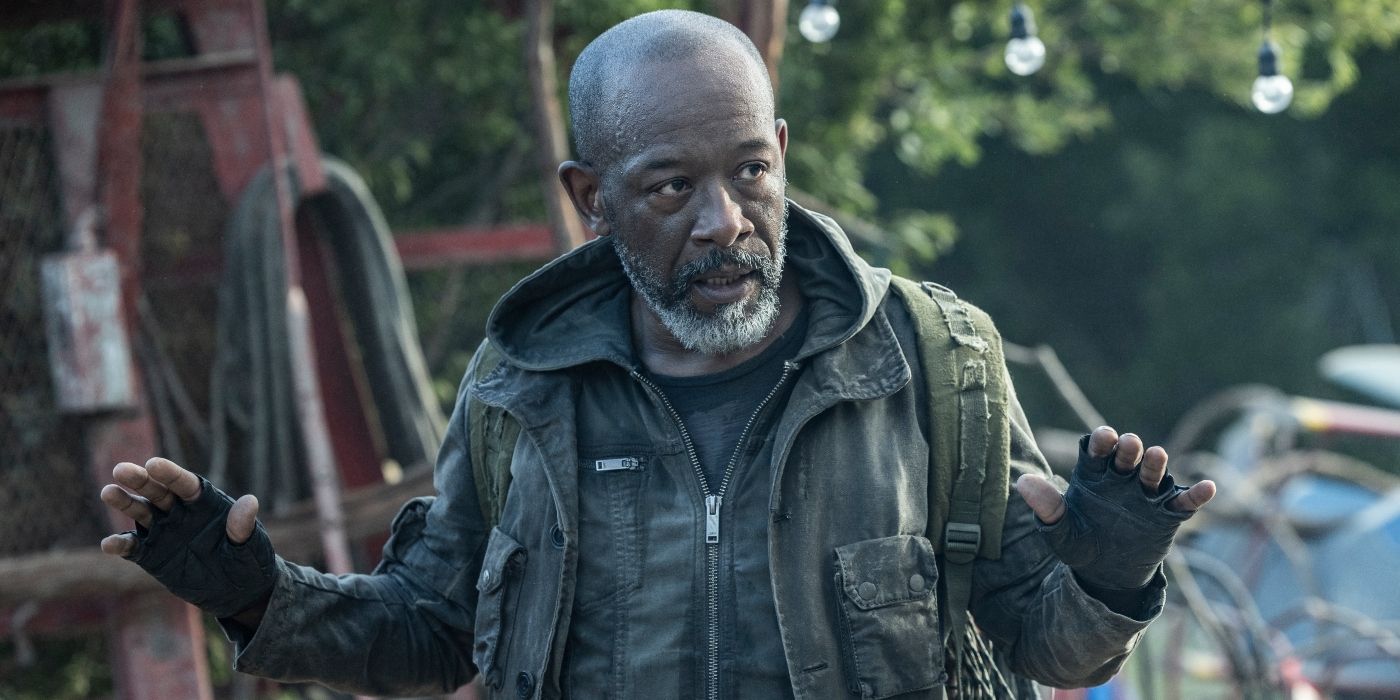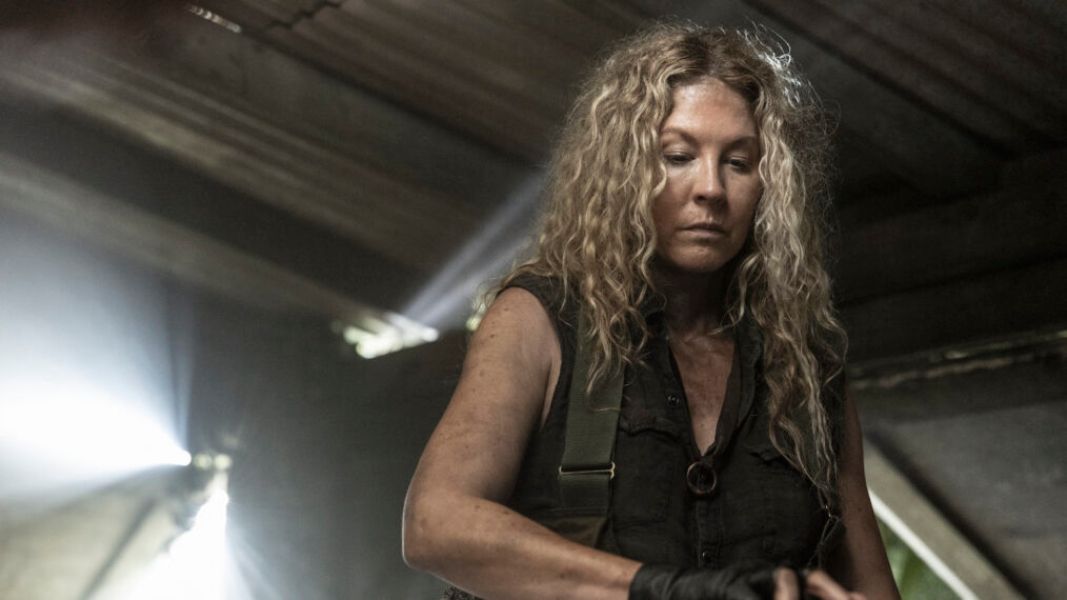
The end may be in sight for AMC’s Fear the Walking Dead but a late plot development could ensure longevity for The Walking Dead franchise. In season 8’s second episode, “Blue Jay,” audiences finally caught up with June (Jenna Elfman), who’s become an expert survivalist since we have last seen her. Oh, and now the showrunners have introduced the possibility of a cure. Going forward, this could change the extended Walking Dead universe in a monumental way. It begs the question: do we want or need to expand the world of The Walking Dead if it is only going to end up being a chore to sit through?
Now that the franchise timelines are starting to align, and we’ve been promised some closure with the hotly-anticipated Rick Grimes (Andrew Lincoln) and Michonne (Danai Garai) miniseries, isn’t it about time fans’ expectations were met? And our questions answered? Maybe a cure (if one really does exist) will provide the universe-overlap and connective tissue hardcore fans have been anticipating for years now. It is unlikely this big plot element will be resolved during Fear’s last season. In all likelihood, it is a carrot the showrunners are dangling to keep viewers on the hook. With The Walking Dead: Dead City premiering soon, it looks like there is no end in sight for the franchise and a cure could play an integral role in the future. But a cure could be the creative turnaround the ongoing tales of the dead desperately need. It remains to be seen if this new direction can reinstate our belief in a pop culture phenomenon that was once event television.
Is There Really a Cure in ‘Fear The Walking Dead’?

In the June-centric episode “Blue Jay,” June is now a wood-dwelling vigilante who has honed her Macgvyer-like stealth and survival skills to take on current villain PADRE. A move that doesn’t make a lick of sense considering we’ve heard countless times, over the course of a handful of episodes, how formidable PADRE is and what they’ll do to people who cross them. Audiences have yet to see evidence to support these claims. So far we’ve been offered very little and PADRE doesn’t seem any more evil than The Commonwealth or CRM.
Over a seven-year period and in swampland spanning a 20-mile radius, June has been using tranquilizer darts to subdue and cut off PADRE soldier’s fingers, as post-apocalyptic keepsakes and as a finger up (sorry) to PADRE’s authoritarian tactics. This all-seeing, all-knowing organization has been ambushed multiple times by the same person and so lacking in medical technicians, they need to strong-arm a nurse. The secondary plot involves Sherry (Christine Evangelista), Dwight (Austin Amelio), whose child-catching activities are interrupted by June and a stowaway: their kid Finch (Gavin Warren). At her shack in the woods, June is approached by Adrian (Jonathan Medina) for help in rescuing his daughter from PADRE. A hostile June refuses, for reasons that will become clear later on. Sherry and Dwight, at a loss about what to do with Finch, end up at an abandoned carriage alongside June. Finch is suffering from appendicitis and needs medical attention, which June can offer. The train carriage had been used in the past by PADRE to conduct experiments on people and potentially find a cure. June’s medical expertise was exploited (at gunpoint) by PADRE by using radiation and other barbaric methods to achieve their aims and she is guilt-ridden as a result.
So if the CDC and renowned scientists are unable to develop a cure, are we to believe June can accomplish it in an abandoned train car with spotty electricity? Sherry and Dwight have a similar will-they/won’t argument about returning Finch to PADRE as Morgan (Lennie James) and Madison (Kim Dickens) had in the previous episode. The chained-up walkers infesting the carriage break out and June confesses her complicity in Adrian’s daughter’s death. Overcome with grief, Adrian lets himself be consumed by the walkers. The leather-clad PADRE villain Shrike (Maya Eshet) outwits our heroes, putting June in a position where she has no choice but to comply. The search for a cure begins.
What Would a Cure Mean for ‘The Walking Dead’ Universe?

In the Season 1 finale of The Walking Dead, “TS-19,” Rick Grimes and his group arrived at the CDC searching for answers and to see if a cure existed and if the world might one day be restored. Virologist Edwin Jenner (Noah Emmerich) was the last man standing at the facility and informed Rick, in no uncertain terms, there is and will not be a cure. Emmerich reprised his role in The Walking Dead: World Beyond, referencing variant walkers. It feels quite sudden to come up with this possibility so late in the game. It demonstrates a lack of unique ideas, like the creators threw a few ideas at a wall and hoped one would stick. A cure coming into existence in this universe could focus the narrative or alternatively, send it spinning off into a dozen different story threads which won’t be resolved anytime soon.
This makes more sense, at least commercially. The Walking Dead and its subsequent spin-offs are cash cows to be milked. A cure would offer resolution when interest is waning — and might turn out to be merely a McGuffin. A cure in this post-apocalyptic landscape would create an information network, drawing interest and attention from other powerful groups. So far in Fear, the exploration of individual groups has been sketchy at best, and has never fully capitalized on the potential of communities they have come into contact with. PADRE is continuing this trend. It would have helped matters if PADRE had not been brought in as a new organization but as an adjunctive group to the likes of CRM. This would provide some much-needed overlap and cohesion with the overall mythology. So is the cure setting the tone for the last season of Fear? Or will the powers that be prolong our agony by moving the plot forward at a walker’s pace?





